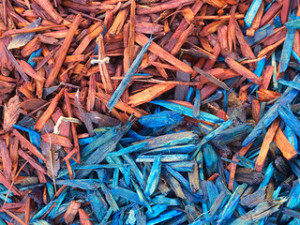Pests in Mulch
By Chris Williams on June 2, 2015.

Most of the pests that end up in a home come in from the homeowner’s own yard. And they don’t necessarily come from very far away in that yard. Many different pests live right around the foundation of our houses since that area provides heat, moisture, vegetation, food – often because we’ve applied too much mulch.
Around our homes, we see ornamental mulch as a good thing. Unfortunately, insects, spiders, and other arthropod pests see mulch as a good thing, too. The biggest advantage to mulch cover from a pest’s point of view is that it holds in moisture. Most insects require moisture to keep their bodies from drying out. Mulch can also provide food in the form of decaying vegetation if you’re using organic mulch, or in the form of other insects if you’re a predator. And, mulch provides warmth, shelter and hiding places for all kinds of critters.
Who’s Living in That Mulch?
Because organic mulches (shredded wood, bark, or chips, sawdust, pine needles, grass clippings, straw) are made of plant material that gradually decomposes, they attract insects and arthropods that feed on rotting vegetation such as millipedes, sowbugs or pillbugs, cockroaches, slugs, earwigs, and crickets, to name a few. Arthropod predators like spiders, centipedes, ants, and ground beetles also occupy mulch where they find insects to feed on. Subterranean termites also benefit from a heavy mulch layer around the foundation because they can then bypass any pesticide barrier in the soil and can enter your home by traveling through the damp mulch instead.
Guidelines for Using Mulch
This doesn’t mean you have to give up having nicely mulched foundation plantings. Just don’t overdo it (see Apply That Mulch With Insects in Mind).
1. Don’t pile it on. Shredded wood and bark mulches should be no deeper than 2-3 inches after settling. Mulch that is too deep stays damp for too long. Coarser mulches that allow air circulation, such as pine bark nuggets, can be as deep as 4 inches.
2. Leave a mulch-free barrier. Keep at least 12 inches between mulch and your home’s foundation to keep pests away from exterior walls. Leave bare ground or add a border strip of crushed stone or pebbles.
3. Minimize moisture around the foundation. Make sure that downspouts, drainpipes, and spigots are not emptying directly onto mulched beds, keeping them wet.
4. Consider using inorganic mulches. Mulches that are not made of plant material are not attractive to pests. Some examples are gravel, pebbles, rock chips, crushed stone, plastic film, and woven landscaping fabrics.
5. Call Colonial Pest. We can schedule a perimeter pesticide treatment around the foundation of your home. When you sign up for our Preventative Maintenance Program, you receive two scheduled foundation pest barrier treatments per year, and more service if you need it. Combine our service with good mulch management and eliminate indoor pests in mulch and from your home.